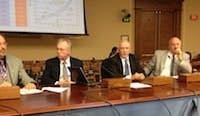On June 24, 2013, Danfoss joined with the Alliance to Save Energy and the Water Environment Federation to host “The Imperative for a Sustainable Infrastructure”—a briefing on Capitol Hill to discuss water and energy efficiency.
The briefing, which drew attendance from regulatory agencies, congressional staff, advocacy organizations and industry, addressed existing technologies, best practices and various policies and financing mechanisms that can be applied to improve water and energy efficiency in water and wastewater treatment plants. Speakers included: John Masters, vice president of sales – water, Danfoss; Ed McCormick, manager of wastewater engineering, East Bay Municipal Utility District (EBMUD) and vice president, Water Environment Federation; and Mark Wagner, vice president for government relations, Johnson Controls
According to the experts’ testimony, improving efficiency in all sectors is critical to boosting the U.S. economy, preserving the environment and increasing energy security.
Water and wastewater facilities account for approximately 3% to 4% of the United States’ annual electricity consumption. The U.S. Department of Energy estimates that the water and wastewater treatment sector is the third largest energy consuming sector, using more than 55 billion kilowatt-hours per year. Between 3,000 and 6,000 gal of water are required to power one 60W incandescent bulb for 12 hours a day over the course of one year, according to the U.S. Environmental Protection Agency.
For many U.S. municipalities, energy costs for water and wastewater treatment services are a significant portion of operating costs. Energy efficiency, therefore, represents a powerful tool to reduce costs, enhance customer service and improve sustainability.
The briefing highlighted two existing technologies that could improve the energy use of wastewater treatment plants.
Both anaerobic digestion and cogeneration have helped EBMUD become the first net-positive energy wastewater treatment agency, producing more energy than it consumers. McCormick explained that EBMUD’s cogeneration plant has a capacity of 11.1 MW, which exceeds the demand of the main wastewater treatment plant, thereby enabling EBMUD to sell electricity into the grid.
Masters demonstrated the energy saving potential of variable frequency drives (VFDs), a readily available and proven technology.
“By updating motor-driven electricity systems, we could save up to 2 billion kWh, or 11% to 18%, annually,” said Masters. “Variable speed technology can be applied in both new and retrofit applications, is easily implemented and can save up to 20% on electrical costs and 30% on annual water usage.” He also explained how off-grid pumping systems and off-peak power technologies could result in further savings and reduced greenhouse gas emissions.
However, while these existing technologies are highly effective, viable solutions, they must be utilized properly and deployed rapidly in order to realize real efficiency gains and reduce costs. Today, financing and is one of the most significant obstacles to implementing energy efficiency projects, dictating a need for the development of financial solutions and incentives, particularly for water and wastewater treatment plants.
Fortunately, when technologies like cogeneration and variable frequency drives are deployed in water applications, they result in energy savings that serve as revenue streams for the municipality. Energy service companies and energy savings performance contracts are critical to helping advance these technologies, and can provide the funding required to help this reduced energy use pay for the cost of the initial investment.
“A good retrofit example,” explained Masters, “is the wastewater treatment plant in Moundsville, W.Va. After updating its three 75-hp centrifugal blowers with one 100-hp and one 50-hp rotary lobe blower, each installed with a Danfoss VLT AQUA Drive, and reducing net-revenue water—the water lost through leaks or metering inaccuracies before reaching the customer, the plant has slashed its energy costs by $50,000 to $60,000 annually.”
“These technologies make good financial sense, but it is critical that we seek ways to accelerate the deployment of these existing technologies in order to create the more efficient water systems that will further encourage rapid deployment of future technology deployments.”
Source: Danfoss


